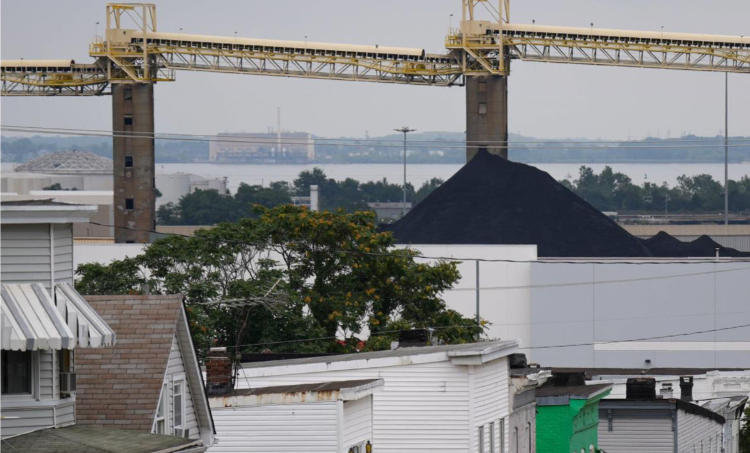

The World Wants American Coal.
Curtis Bay residents say they pay the price. Adam Willis, Daniel Zawodny and Ramsey Archibald, 6/6/2024 5:30 a.m. EDT
A large pile of coal can be seen from the surrounding neighborhood outside of the CSX facility in Curtis Bay on Aug. 4, 2023. (Ulysses Muñoz/The Baltimore Banner)
Charles Schultz was sitting in his living room when it sounded like a bomb went off. Then the sky turned dark.
Throughout his 50-plus years living in Curtis Bay — an isolated community wedged into the southern corner of Baltimore — he’d gotten used to seeing soot pile up on his windowsill. Now coal dust was raining down onto his street, a tower smoldering on the CSX coal pier just a stone’s throw from his doorstep.
For Schultz and many of his neighbors, the late 2021 explosion was a breaking point, drawing citywide attention they thought might push coal out of their neighborhood for good. Yet years later, Baltimore is exporting record amounts of coal and community members say the neighborhood is still choked by coal dust even as the rest of the country is largely leaving the polluting fuel behind.
The South Baltimore coal piers operated by CSX Transportation, one of the dominant rail companies in the eastern United States, are governed by a state environmental permit, which the company is seeking to renew for the first time since a buildup of methane gas caused the explosion that shook the neighborhood two years ago. The state environmental department is expected to release a preliminary decision on the permit in the coming weeks, the culmination of a monthslong process punctuated by sometimes tense meetings with Curtis Bay residents.
There’s reason to believe things might be different this time. Gov. Wes Moore has set ambitious climate goals that will not only require Maryland to phase out fossil fuels over the next 20 years, but also put new weight on delivering justice for the low-income communities living at the front lines of industry.
Jun 1, 2024
While Maryland regulators argue they don’t have the power to shut down the CSX piers — the company is licensed under federal law to export coal — the permit could offer a lever to clamp down on the site. Short of denying CSX its permit, state regulators could mandate stricter protections against coal dust or even force the company to enclose its open-air terminal.
But CSX has rejected state findings about the scope of the problem, and payoff for coal leaving the Port of Baltimore is big. The state’s impending decision comes as business at Baltimore’s two coal terminals has reached an all-time peak — and as officials in the Moore administration remain almost singularly focused on fully reopening the port in the wake of the March Francis Scott Key Bridge collapse.
Already the second largest coal terminal in the United States, exports through the Port of Baltimore soared last year, leaving Curtis Bay at the mercy of a voracious international appetite for coal.
Some longtime residents of the neighborhood are resigned to a future in which coal trains keep rolling through their neighborhood and mountains of coal keep stacking up next-door. They’ve seen their pleas ignored plenty of times before.
“CSX ain’t gonna do nothing for you, and the politicians ain’t doing nothing about it,” said Schultz. “So this is where you’re at.”
Trump Orders Protect Aging, Polluting Coal Plants and Allow More Mining President Donald Trump signed…
The DASH diet's power lies in its well-balanced plan that delivers specific nutrients proven to…
AG Marshall supports federal push to reopen coal plants Alabama Attorney General Steve Marshall wrote…
Coal Creeps Back as Gas Gets Pricey Article By Tsvetana Paraskova - Mar 26, 2025,…
Toolbox Talk: “Posture For A Healthy Back” What is good posture? Posture is the position…
This website uses cookies.